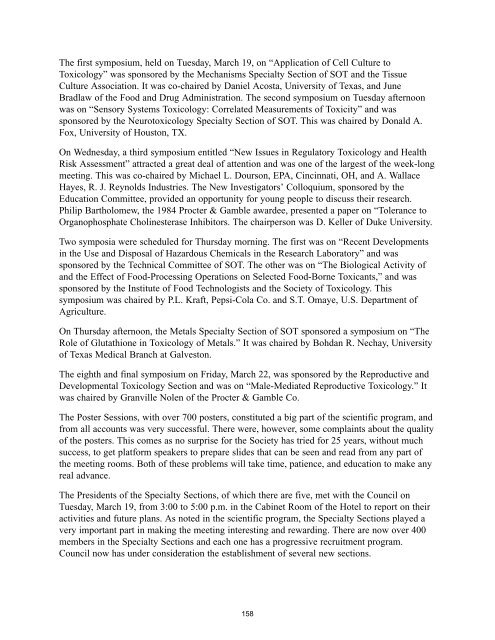SOCIETY O. TOXICOLOGY HISTORY - Society of Toxicology
SOCIETY O. TOXICOLOGY HISTORY - Society of Toxicology
SOCIETY O. TOXICOLOGY HISTORY - Society of Toxicology
You also want an ePaper? Increase the reach of your titles
YUMPU automatically turns print PDFs into web optimized ePapers that Google loves.
The first symposium, held on Tuesday, March 19, on “Application <strong>of</strong> Cell Culture to<br />
<strong>Toxicology</strong>” was sponsored by the Mechanisms Specialty Section <strong>of</strong> SOT and the Tissue<br />
Culture Association. It was co-chaired by Daniel Acosta, University <strong>of</strong> Texas, and June<br />
Bradlaw <strong>of</strong> the Food and Drug Administration. The second symposium on Tuesday afternoon<br />
was on “Sensory Systems <strong>Toxicology</strong>: Correlated Measurements <strong>of</strong> Toxicity” and was<br />
sponsored by the Neurotoxicology Specialty Section <strong>of</strong> SOT. This was chaired by Donald A.<br />
Fox, University <strong>of</strong> Houston, TX.<br />
On Wednesday, a third symposium entitled “New Issues in Regulatory <strong>Toxicology</strong> and Health<br />
Risk Assessment” attracted a great deal <strong>of</strong> attention and was one <strong>of</strong> the largest <strong>of</strong> the week-long<br />
meeting. This was co-chaired by Michael L. Dourson, EPA, Cincinnati, OH, and A. Wallace<br />
Hayes, R. J. Reynolds Industries. The New Investigators’ Colloquium, sponsored by the<br />
Education Committee, provided an opportunity for young people to discuss their research.<br />
Philip Bartholomew, the 1984 Procter & Gamble awardee, presented a paper on “Tolerance to<br />
Organophosphate Cholinesterase Inhibitors. The chairperson was D. Keller <strong>of</strong> Duke University.<br />
Two symposia were scheduled for Thursday morning. The first was on “Recent Developments<br />
in the Use and Disposal <strong>of</strong> Hazardous Chemicals in the Research Laboratory” and was<br />
sponsored by the Technical Committee <strong>of</strong> SOT. The other was on “The Biological Activity <strong>of</strong><br />
and the Effect <strong>of</strong> Food-Processing Operations on Selected Food-Borne Toxicants,” and was<br />
sponsored by the Institute <strong>of</strong> Food Technologists and the <strong>Society</strong> <strong>of</strong> <strong>Toxicology</strong>. This<br />
symposium was chaired by P.L. Kraft, Pepsi-Cola Co. and S.T. Omaye, U.S. Department <strong>of</strong><br />
Agriculture.<br />
On Thursday afternoon, the Metals Specialty Section <strong>of</strong> SOT sponsored a symposium on “The<br />
Role <strong>of</strong> Glutathione in <strong>Toxicology</strong> <strong>of</strong> Metals.” It was chaired by Bohdan R. Nechay, University<br />
<strong>of</strong> Texas Medical Branch at Galveston.<br />
The eighth and final symposium on Friday, March 22, was sponsored by the Reproductive and<br />
Developmental <strong>Toxicology</strong> Section and was on “Male-Mediated Reproductive <strong>Toxicology</strong>.” It<br />
was chaired by Granville Nolen <strong>of</strong> the Procter & Gamble Co.<br />
The Poster Sessions, with over 700 posters, constituted a big part <strong>of</strong> the scientific program, and<br />
from all accounts was very successful. There were, however, some complaints about the quality<br />
<strong>of</strong> the posters. This comes as no surprise for the <strong>Society</strong> has tried for 25 years, without much<br />
success, to get platform speakers to prepare slides that can be seen and read from any part <strong>of</strong><br />
the meeting rooms. Both <strong>of</strong> these problems will take time, patience, and education to make any<br />
real advance.<br />
The Presidents <strong>of</strong> the Specialty Sections, <strong>of</strong> which there are five, met with the Council on<br />
Tuesday, March 19, from 3:00 to 5:00 p.m. in the Cabinet Room <strong>of</strong> the Hotel to report on their<br />
activities and future plans. As noted in the scientific program, the Specialty Sections played a<br />
very important part in making the meeting interesting and rewarding. There are now over 400<br />
members in the Specialty Sections and each one has a progressive recruitment program.<br />
Council now has under consideration the establishment <strong>of</strong> several new sections.<br />
158
















